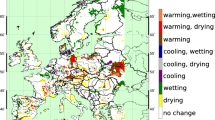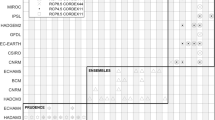Abstract
Weather services base their operational definitions of “present” climate on past observations, using a 30-year normal period such as 1961–1990 or 1971–2000. In a world with ongoing global warming, however, past data give a biased estimate of the actual present-day climate. Here we propose to correct this bias with a “delta change” method, in which model-simulated climate changes and observed global mean temperature changes are used to extrapolate past observations forward in time, to make them representative of present or future climate conditions. In a hindcast test for the years 1991–2002, the method works well for temperature, with a clear improvement in verification statistics compared to the case in which the hindcast is formed directly from the observations for 1961–1990. However, no improvement is found for precipitation, for which the signal-to-noise ratio between expected anthropogenic changes and interannual variability is much lower than for temperature. An application of the method to the present (around the year 2007) climate suggests that, as a geographical average over land areas excluding Antarctica, 8–9 months per year and 8–9 years per decade can be expected to be warmer than the median for 1971–2000. Along with the overall warming, a substantial increase in the frequency of warm extremes at the expense of cold extremes of monthly-to-annual temperature is expected.








Similar content being viewed by others
References
Boer GJ, Yu B (2003) Climate sensitivity and climate state. Clim Dyn 21:167–176
Brier GW (1950) Verification of forecasts expressed in terms of probability. Mon Wea Rev 78:1–3
Brohan P, Kennedy JJ, Harris I, Tett SFB, Jones PD (2006) Uncertainty estimates in regional and global observed temperature changes: a new dataset from 1850. J Geophys Res 111:D12106. doi:10.1029/2005JD006548
Candille G, Talagrand O (2005) Evaluation of probabilistic prediction systems for a scalar variable. Q J R Meteorol Soc 131:2131–2150
Harvey LDD (2004) Characterizing the annual-mean climatic effect of anthropogenic CO2 and aerosol emissions in eight coupled atmosphere-ocean GCMs. Clim Dyn 23:569–599
Hegerl GC, Zwiers FW, Braconnot P, Gillett NP, Luo Y, Marengo Orsini JA, Nicholls N, Penner JE, Stott PA (2007) Understanding and attributing climate change. In: Solomon S et al (eds) Climate change 2007: the physical science basis. Cambridge University Press, London, pp 663–745
Hersbach H (2000) Decomposition of the continuous ranked probability score for ensemble prediction systems. Weather Forecast 15:559–570
Huntingford C, Cox PM (2000) An analogue model to derive additional climate change scenarios from existing GCM simulations. Clim Dyn 16:575–586
Kjellström E, Bärring L, Jacob D, Jones R, Lenderink G, Schär C (2007) Variability in daily maximum and minimum temperatures: recent and future changes over Europe. Clim Change. doi:10.1007/s10584-006-9220-5
Meehl GA, Covey C, Delworth T, Latif M, McAvaney B, Mitchell JFB, Stouffer RJ, Taylor KE (2007a) The WCRP CMIP3 multimodel dataset: a new era in climate change research. Bull Am Meteorol Soc 88:1383–1394
Meehl GA, Stocker TF, Collins W, Friedlingstein P, Gaye A, Gregory J, Kitoh A, Knutti R, Murphy J, Noda A, Raper S, Watterson I, Weaver A, Zhao Z-C (2007b) Global climate projections. In: Solomon S et al (eds) Climate change 2007: the physical science basis. Cambridge University Press, London, pp 747–845
Mitchell TD (2003) Pattern scaling: an examination of the accuracy of the technique for describing future climate. Clim Change 60:217–242
Mitchell JFB, Johns TC, Eagles M, Ingram WJ, Davis RA (1999) Towards the construction of climate change scenarios. Clim Change 41:547–581
Mitchell TD, Carter TR, Jones PD, Hulme M, New M (2004) A comprehensive set of high-resolution grids of monthly climate for Europe and the globe: the observed record (1901–2000) and 16 scenarios (2001–2100). Tyndall Centre Working Paper 55, 30 pp
Nakićenović N, Alcamo J, Davis G, de Vries B, Fenhann J, Gaffin S, Gregory K, Grübler A, Jung TY, Kram T, La Rovere EL, Michaelis L, Mori S, Morita T, Pepper W, Pitcher H, Price L, Raihi K, Roehrl A, Rogner H-H, Sankovski A, Schlesinger M, Shukla P, Smith S, Swart R, van Rooijen S, Victor N, Dadi Z (2000) Emission scenarios. A special report of Working Group III of the Intergovernmental Panel on Climate Change. Cambridge University Press, London, 599 pp
New M, Hulme M, Jones P (2000) Representing twentieth-century space-time climate variability. Part II Development of 1901–96 monthly grids of terrestrial surface climate. J Climate 13:2217–2238
Räisänen J (2001) CO2-induced climate change in CMIP2 experiments: quantification of agreement and role of internal variability. J Climate 14:2088–2104
Räisänen J, Ruokolainen L (2006) Probabilistic forecasts of near-term climate change based on a resampling ensemble technique. Tellus 58A:461–472
Santer BD, Wigley TML, Schlesinger ME, Mitchell JFB (1990) Developing climate scenarios from equilibrium GCM results. Report 47. Max-Planck Institut für Meteorologie, Hamburg, 29 pp
Stanski HR, Wilson LJ, Burrows WR (1989) Survey of common verification methods in meteorology. Research report 89–5, Atmospheric Environment Service Forecast Research Division, Canada
Stott PA, Tett SFB, Jones GJ, Allen MR, Mitchell JFB, Jenkins GJ (2000) External control of 20th century temperature by natural and anthropogenic forcings. Science 290:2133–2137
Wilks DS (1995) Statistical methods in the atmospheric sciences. Academic Press, New York, 467 pp
World Meteorological Organization (1989) Calculation of monthly and annual 30-year standard normals. WMO-TD/NO. 341, Geneva, 11 pp
Acknowledgments
We acknowledge the modeling groups for making their model output available as part of the WCRP’s CMIP3 multi-model dataset, the Program for Climate Model Diagnosis and Intercomparison (PCMDI) for collecting and archiving this data, and the WCRP’s Working Group on Coupled Modelling (WGCM) for organizing the model data analysis activity. The WCRP CMIP3 multi-model dataset is supported by the Office of Science, US Department of Energy. This research has been supported by the Academy of Finland (decision 106979) and by the ACCLIM project within the Finnish Climate Change Adaptation Research Programme ISTO.
Author information
Authors and Affiliations
Corresponding author
Appendix: Brier score and the continuous ranked probability score
Appendix: Brier score and the continuous ranked probability score
Consider a binary event E. For example, E might be defined to occur when the mean temperature of a given month in a given place exceeds a given threshold ξ. The Brier score B (Brier 1950; Wilks 1995) for this threshold value is defined as
where o i (ξ) = 1 (0) if E occurs (does not occur) in case i and p i (ξ) is the corresponding forecast probability. N is the total number of cases verified. The better the forecast, the lower the Brier score. For a perfect deterministic forecast system, which forecasts a probability of 1 (0) always when E occurs (does not occur), B = 0.
The Brier score can be evaluated for any threshold value ξ. Integrating B over ξ gives the continuous ranked probability score CRPS (Stanski et al. 1989; Hersbach 2000; Candille and Talagrand 2005). When all values of ξ are given the same weight, as is done in this study
By this definition, CRPS gets the units of the forecast variable: °C for temperature and mm/day for precipitation.
Rights and permissions
About this article
Cite this article
Räisänen, J., Ruokolainen, L. Estimating present climate in a warming world: a model-based approach. Clim Dyn 31, 573–585 (2008). https://doi.org/10.1007/s00382-007-0361-7
Received:
Accepted:
Published:
Issue Date:
DOI: https://doi.org/10.1007/s00382-007-0361-7




